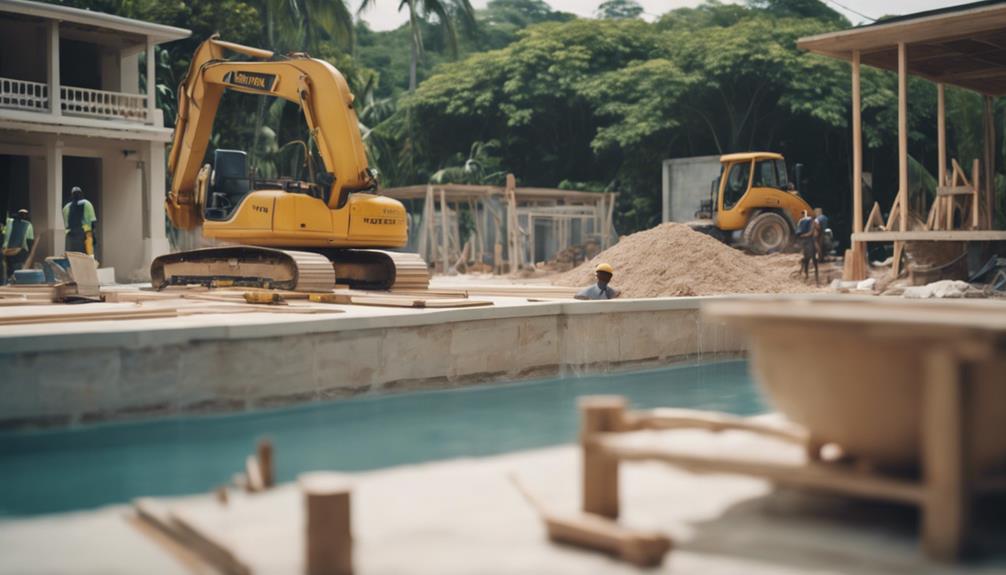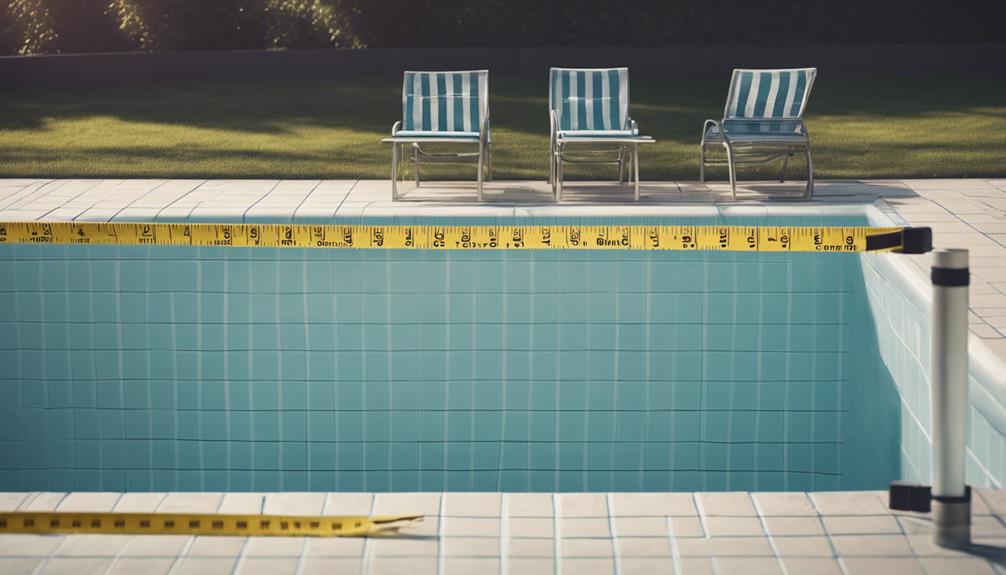To accurately calculate the surface area of your pool, begin by familiarizing yourself with the specific formulas and measurements needed for each shape. For round pools, make sure to measure the diameter accurately. Rectangular or square pools will require precise measurements of both length and width, aligned parallel to the edges. To calculate the rectangular area, simply multiply the length by the width. When dealing with circular areas, calculate the radius for your calculations. The triangular area can be found by multiplying half of the base by the height. Combine all of these individual areas to find the total surface area. Don’t forget to check the pool depth at both shallow and deep points. These tips will ensure accurate calculations and help you make informed decisions regarding maintenance and treatment. More detailed information is available to further assist you in calculating your pool area.
Key Takeaways
- Measure pool length, width, and depth accurately for correct surface area calculation.
- Use specific formulas based on pool shape (circular, triangular, etc.) for accurate results.
- Convert all measurements to the same unit for consistency in calculations.
- Sum up individual surface areas of different sections for total pool area determination.
- Understanding pool area aids in maintenance, heating needs, and chemical treatments.
Pool Shape Selection
When determining the surface area of your pool, the first step is selecting the appropriate pool shape for accurate calculations.
The shape of your pool, whether it be round, rectangular, or square, plays an important role in determining the correct formula for calculating its surface area.
For round pools, you'll need to measure the diameter accurately to apply the correct equation.
In contrast, rectangular or square pools require precise measurements of the length and width to calculate the surface area effectively.
It's vital to make sure that your estimations align perfectly parallel to the edges of the pool to obtain accurate results.
Understanding the specific shape of your pool is fundamental in selecting the appropriate formula for calculating its surface area.
Gathering Necessary Measurements

To accurately calculate your pool's surface area, start by measuring the pool's length and width, and determine the shape of your pool. Make sure to take parallel measurements to the pool edges for precise calculations.
Understanding these points is essential for obtaining accurate results when determining the surface area of your pool.
Measure Pool Length
You can measure the length of your rectangular pool using a tape measure along one side, guaranteeing parallel measurements for accuracy.
To gather the necessary measurements effectively, follow these steps:
- Break Down Irregular Shapes: For irregular pools, simplify the shape into basic forms and measure individual lengths to determine the total length accurately.
- Consider Round Pools: In the case of round pools, the diameter measurement functions as the length. Make sure the diameter passes through the center for correct calculation of the pool's area.
- Precision is Key: Accurate length measurements are crucial for formulating the surface area formula and calculating the total area of the pool correctly.
- Account for Extensions: Gather all required length measurements, including any extensions or irregularities, to guarantee precise calculations of the pool's surface area.
Ensuring precise measurements will allow you to accurately calculate your pool's surface area for maintenance and other purposes.
Calculate Pool Width
Measuring the width of your pool involves determining the distance between its two longest parallel sides. For rectangular pools, this means finding the length of the pool's widest side.
Oval pools require locating the widest part to accurately measure the width. Similarly, with round pools, measuring the diameter across the widest point is essential to determine the width.
These precise width measurements are vital for calculating the surface area of your pool accurately. To guarantee an exact calculation, make sure to take parallel measurements to the pool edges.
Determine Pool Shape
Identify the shape of your pool to gather the necessary measurements for calculating its surface area accurately. When determining your pool shape, consider whether it's rectangular, circular, oval, or irregular. Each shape requires specific measurements and formulas to calculate surface area correctly.
Follow these steps to guarantee precise measurements:
- Rectangular Pools: Measure the length and width of the pool along the longest and widest points, aligning the measurements parallel to the pool's edges.
- Circular Pools: Measure the diameter across the pool to calculate the radius, making sure the measurements are taken accurately from one edge to the opposite edge through the center.
- Oval Pools: Measure the two axes (a and b) of the oval pool and the height (h), aligning the measurements parallel to the major and minor axes.
- Irregular Pools: Break down the irregular shape into simpler geometric forms to calculate the surface area accurately using known formulas for those shapes.
Measuring Pool Length

To measure the length of your pool accurately, focus on a specific side and use a tape measure. For a rectangular or square pool, place the tape measure along one of the longer sides and measure from end to end.
In the case of circular pools, determine the diameter by measuring from one edge to the opposite edge, passing through the center. Oval pools require measuring the longest straight line across the pool and then taking a perpendicular measurement for accurate length calculation.
Remember, precise length measurements are crucial for accurately calculating the pool's surface area. Double-check your measurements to guarantee precision in determining the pool's length.
Measuring Pool Width

When determining the width of your rectangular pool, focus on measuring the distance between the two longest parallel sides. This measurement is important for accurate surface area calculations and maintenance planning.
Here are some key points to keep in mind:
- Rectangular Pool: Measure the width by determining the distance between the longest parallel sides.
- Square Pool: In a square pool, the width is the same as the length, as all sides are equal.
- Circular Pool: The diameter measurement serves as the width across the center of a circular pool.
- Oval Pool: Measure the widest point for accurate width calculation in oval pools.
Ensuring you measure the width of your pool correctly is essential for accurate surface area calculations and efficient maintenance. By focusing on this step, you set the foundation for proper pool care and management.
Calculating Rectangular Area

To calculate the surface area of a rectangular pool, you'll multiply the length by the width to get the base area.
The formula for the area of a rectangle is 2lw + 2lh + 2wh, where l is the length, w is the width, and h is the height.
This computation is essential for accurately determining the amount of materials needed for pool maintenance and renovation.
Length X Width Calculation
Calculating the surface area of a rectangular pool involves multiplying the length and width measurements. To guarantee an accurate result, make sure both the length and width are in the same unit of measurement before performing the calculation.
The formula for the rectangular pool area is simplified to lw, making it a straightforward process for pools with a simple shape. Accurate measurements of both the length and width are essential for precise surface area calculation, as any errors in these measurements will affect the final result.
Formula for Area
The formula for calculating the surface area of a rectangular pool involves adding the products of length and width with width and height, resulting in 2lw + 2lh + 2wh.
By understanding this formula, you can accurately determine the total surface area of your pool or spa. This calculation includes considering all sides: the top and bottom (length x width), the front and back (width x height), and the sides (length x height).
Knowing the dimensions of your rectangular pool is essential for various reasons. It aids in estimating chemical dosing accurately, sizing equipment appropriately, simplifying maintenance planning, tackling renovation projects effectively, and ensuring compliance with regulations.
Utilizing the correct formula for a rectangular pool guarantees precise surface area determination, which has a significant impact on decisions related to pool finish and maintenance requirements.
Therefore, mastering the formula for calculating the area of your pool is vital for effective pool management and enjoyment.
Calculating Circular Area

Measure the radius of your circular pool by finding half the diameter from the center to the edge.
Once you have the radius, you can calculate the surface area using the formula 2πr² + 2πrh, where r represents the radius and h stands for the height of the pool.
Here are some key points to keep in mind when calculating the circular area of your swimming pool:
- The radius is essential in determining the area of the pool, so make sure to take an accurate measurement from the center to the edge.
- The height of the pool, from the water surface to the bottom, also plays a significant role in the surface area calculation.
- Make sure to convert all measurements to the same unit system before applying them to the formula for accurate results.
- Calculating the circular area not only helps in determining the pool's surface area but also aids in decisions regarding pool finishes, chemical treatments, and heating system requirements.
Calculating Triangular Area

To determine the area of a triangle, you need to identify the base and height measurements. The base is the bottom side of the triangle, and the height is the perpendicular distance from the base to the opposite vertex.
Measure the base of the triangular area across the bottom and make sure the height is a perpendicular line from the base to the opposite vertex. Make sure both the base and height measurements are in the same unit, such as feet or meters, before calculating the area.
Once you have these measurements, plug them into the formula A = 0.5 * base * height to find the triangular section's area accurately.
Understanding this calculation method is essential for accurately determining your pool's total surface area with different shapes and sections.
If you require further assistance or have any questions, feel free to contact us at the provided phone number for guidance.
Adding Up Total Surface Area

For a precise assessment of your pool's total surface area, integrate all the individual surface areas of its various shapes using the appropriate formulas. Make sure to convert all measurements to the same unit before applying the formulas to guarantee accuracy.
Here are some key steps to help you add up the total surface area effectively:
- Gather your measuring tape and note down the dimensions of each section of your pool accurately.
- Use the designated formula for each shape present in your pool, such as rectangular, circular, oval, or irregular, to calculate the individual surface areas.
- Add up all the calculated surface areas to obtain the total surface area of your pool.
- Remember that an accurate total surface area calculation is essential for several aspects like pool finish selection, determining chemical requirements, and appropriately sizing components for heating and filtration systems.
Checking Depth for Accurate Calculation

Guarantee accurate calculations by verifying the depth of your pool from the bottom to the top of the pool wall using a tape measure in feet. Understanding the pool depth is crucial for accurate surface area calculations and effective maintenance planning.
If the depth of your pool varies, measure and note the depth at both the shallowest and deepest points. To calculate the average depth, add the shallowest and deepest depths together, then divide by two. This average depth will provide a more precise representation of your pool's overall depth for calculations.
Accurate pool depth measurements play an essential role in determining the water volume, appropriate chemical dosing, and sizing equipment correctly for efficient pool maintenance. Make sure to regularly monitor and update your pool depth measurements to guarantee accurate surface area calculations and to facilitate efficient pool maintenance routines.
Frequently Asked Questions
How to Calculate Surface Area of Pool?
To calculate the surface area of a pool, you need to take into account its shape.
For a rectangular pool, use the formula 2lw + 2lh + 2wh.
Circular pools require 2πr^2 + 2πrh.
Oval pools use πab + (a + b)√((a – b)^2 / 4 + h^2).
Irregular pools entail breaking them down into simpler shapes.
Always convert measurements to the same unit for accurate results.
How to Calculate Water Surface Area?
To calculate water surface area, measure the length and width of the pool. For a rectangular pool, multiply the length by the width.
For a circular pool, use the formula 3.14 times the radius squared.
For an oval pool, use the formula pi times a times b. Irregular pool shapes can be divided into simpler shapes for calculation.
Accurate surface area determination helps in pool maintenance, chemical balance, and equipment sizing.
How to Calculate Surface Area?
To calculate surface area, use the appropriate formula based on your pool shape. For rectangular pools, the formula is 2lw + 2lh + 2wh. For circular pools, it is 2πr^2 + 2πrh. For oval pools, use the formula πab + (a + b)√((a – b)^2 / 4 + h^2). Break down irregular shapes if needed. Convert measurements to the same unit for accuracy.
Consider factors like pool depth, features, and size. Utilize a surface area calculator for precision in determining your pool's surface area.
How to Calculate the Square Footage of a Swimming Pool?
To calculate the square footage of a swimming pool, you need to measure its dimensions based on the shape of the pool. For a rectangular pool, measure the length and width. For circular pools, measure the radius and height. Once you have these measurements, apply the appropriate formulas to determine the surface area.
For irregularly shaped pools, it's best to break them down into simpler forms to ensure accurate calculations. Precise determination of the surface area is crucial for various aspects such as maintenance, chemical balancing, and equipment sizing.
Accurate measurements are essential for the optimal functioning and aesthetics of the pool. Avoid potential issues that may arise from inaccurate calculations by ensuring meticulous measurement techniques are used.
Can I Use These Tips to Calculate the Surface Area of My Swimming Pool for Accurate Measurements?
Yes, you can certainly use these tips to accurately calculate swimming pool surface area. By following the formulas and measurements provided, you will be able to determine the exact surface area of your swimming pool for any necessary renovations or maintenance.
Conclusion
To accurately calculate your pool's surface area, remember to carefully measure the length, width, and depth of the pool. By following the steps outlined in this article, you can guarantee a precise calculation of the total surface area.
Remember, precision in measurement is key to accurately determining the amount of materials needed for maintenance and renovations. Stay diligent in your calculations to enjoy a well-maintained pool for years to come.










